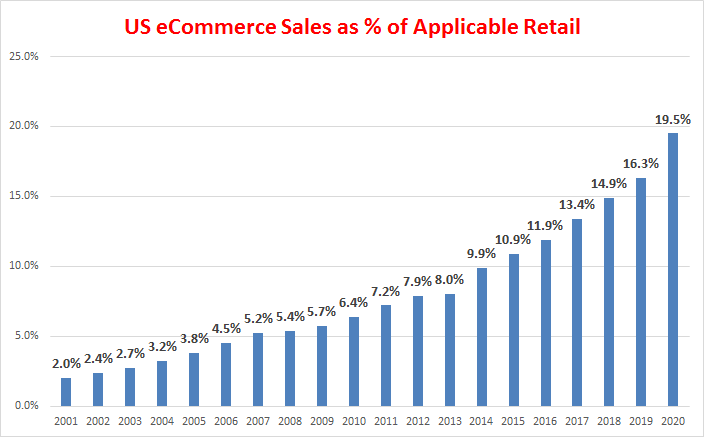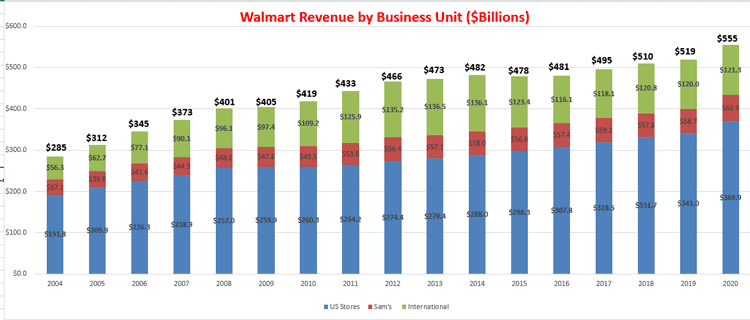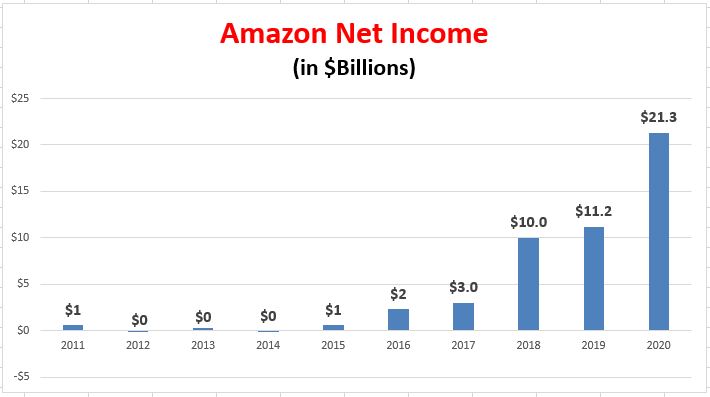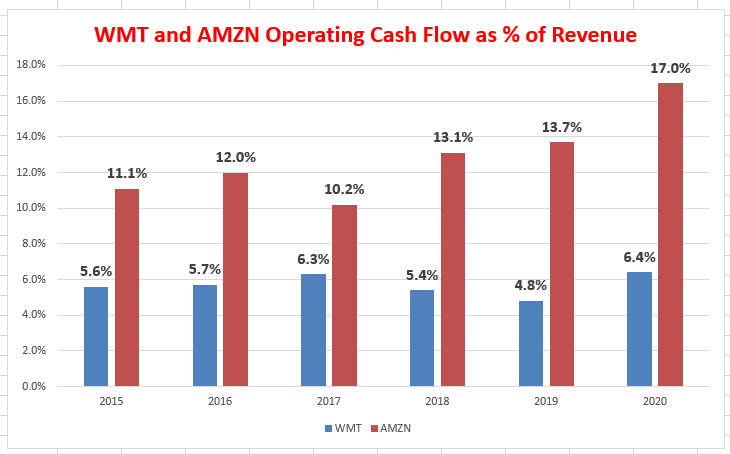My column a few weeks ago on Walmart and Amazon by the Numbers 2021 once again proved very popular. I am very pleased to be backed this week with part 2, as we dig into the data from the world's two most important retailers.
Gilmore Says.... |
 |
| Importantly, Walmart also has to pay a dividend from its cash flow- $6.1 billion worth last year - while Amazon does not. |
 |
What do you say? |
|
| Click here to send us your comments |
| |
|
|
|
To first put the numbers from both of my columns in perspective, let's first look at the rise of US ecommerce. According to the Commerce Dept., ecommerce sales were about 13.8% of total retail sales last year, up from about 9.9% in 2018 - but those total retail numbers include sales of cars, gas stations, restaurants and a few other categories that are not really relevant for comparison.
So, we run the numbers based on the same formula we used in part 1 of this series to analyze Walmart's share of US retail, for which we take total retail and subtract out those non-relevant categories . Using that formula, ecommerce sales were a much higher 19.5% of total US retail sales in 2020, up strongly from 16.3% in 2019 and 14.9% in 2018, as shown in the graphic below. Of course, that share is much higher in some product categories, such as electronics and apparel and growing daily.
The pandemic was very good for ecommerce. However, for the last four quarters, growth has tapered off a bit, averaging around 13.6% quarter-over-quarter.

In my first column, we also graphed the annual percentage growth for Walmart's US retail sales, which slowed noticeably a few years back but have rallied a bit the last few years. After a flat 2019, Walmart US sales jumped an amazing 8.7% in 2020. Below we show the Walmart numbers in absolute terms across its three reporting units: US, Sam's Club, and International.

Walmart has had a CAGR of 4.25% for total sales from 2004 through 2020, but that clearly came much more from the first half of that period than the last few years. Since 2015, total revenue has grown 3.0% annually, but that's with the big 8.7% rise in US sales last year.
Over the same period, international actually fell 0.3% per year, Sam's Club basically is flat and the fastest growth was seen in the most mature segment, US retail, at 4.4%. Walmart grew its US store sales by $29 billion last year - the size of a major retailer on its own.
Switching gears, Amazon for years received much criticism for its consistent failure to really make any money despite the rapid revenue growth, but that started to change in 2016 and really jumped in 2018, as can be seen in the chart below. Net income for 2020 was $21.3 billion, up 90% from 2020, and reached 5.5% of sales, both those numbers easily setting company records.

However, it's worth noting that a huge 59% of its operating income came from Amazon's AWS web services unit. That has not been very widely reported.
Walmart, by comparison, had profits of $13.5 billion last fiscal year, almost $8 billion below Amazon's number, and down a surprising 9.2% versus fiscal 2019 even with the big jump in US sales. Walmart's net income was only 2.4% of sales, far low lower than Amazon's 5.5% margin percent.
During all the years of no profits, some observers said to look at Amazon's cash flow from operations instead of profits, a view which certainly painted a more favorable picture.
Operating cash flow as a percent of revenue has generally been much higher at Amazon than at Walmart for many years - and was almost three times so in 2020, as shown in the chart below.

But there is operating cash flow and then what is called "free cash flow," or operating cash flow minus capital expenditures, and here the story is also interesting.
Amazon had an amazing $66 billion operating cash flow in 2020, and had CapEx of about $40 billion, up from $16.8 billion in 2019. So that means CapEx was 60.6% of operating cash flow, up from 52.3% in 2019. Lots of fulfillment centers still being built.
Walmart, on the other hand, had CapEx of about $10.3 billion - actually down just a bit from $10.7 billion in 2019. With $36.1 billion in operating cash flow, that means CapEx of about 29% of OCF, though with Walmart now generating less OCF than its rival. (Note: as a proxy for official CapEx, I am using spending on real estate, equipment and technology).
Importantly, Walmart also has to pay a dividend from its cash flow- $6.1 billion worth last year - while Amazon does not. So Amazon's operating cash flow minus CapEx spend = $26 billion in 2020. Doing the same calculation with Walmart but also subtracting the dividend leaves it with $19.3 billion in free cash. That is about 75% of Amazon's total.
The dividend factor is huge and a giant advantage for Amazon while it lasts.
I have lots more, but I am out of space. Hope you have enjoyed this look at the numbers.
Any reaction to these numbers from Amazon and Walmart? Any other data you would like to see? Let us know your thoughts at the Feedback button or section below.
Your Comments/Feedback
|